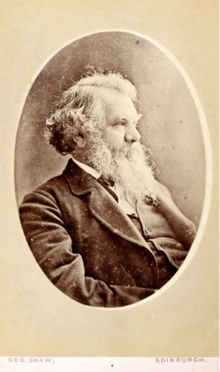Edmund Ronalds
Edmund Ronalds | |
|---|---|
 | |
| Born | 18 June 1819 |
Edmund Ronalds FCS
Upbringing and family

He was born on 18 June 1819 at 48 Canonbury Square in Islington.[1] His father Edmund Sr was a London cheesemonger and the brother of inventor Sir Francis Ronalds and his mother Eliza Jemima was the daughter of Dr James Anderson, who ran a respected school in Hammersmith.[2][3] For most of his childhood the family lived at Brixton Hill but they returned to Islington in 1839 and resided at the east end of Canonbury Place.
He was the eldest of at least 12 children. Five of his siblings moved to New Zealand in the 1850s where his sisters married brothers of Harry Atkinson.[4] Another sister spent her last years in Algiers. Two siblings married into Samuel Greg's cotton-spinning family.[1][3]
Education and career
Ronalds' university education was conducted principally in Germany. His key supervisors for his subsequent career were philosophy professor Jakob Friedrich Fries of the university of Jena, Gustav Magnus, the professor of physics and technology at the University of Berlin, and chemistry professor Justus von Liebig at the University of Giessen, where he was awarded his doctorate in 1842.[1]
On returning home in 1842, he became assistant to Professor
Ronalds resigned his chair at
Research and publication
Ronalds’ doctoral research was in the field of agricultural and physiological chemistry. Analysing wax by oxidation he created succinic acid, and published the results in Liebig's journal.[6]
He discovered
In 1848 he and Thomas Richardson translated and edited Friedrich Ludwig Knapp's book Chemical Technology. The first volumes of a much enlarged second edition were published in 1855.[9] Later volumes in the period to 1867 were written by Richardson and Henry Watts, Ronalds having moved to Bonnington, and a third edition was published in 1889–1903. The book was recognised as a standard text and helped introduce the study of chemical technology at universities in Britain and beyond.[1]
As secretary of the Chemical Society, he edited the first two volumes of the Journal of the Chemical Society for 1849 and 1850. In 1852 he published an analysis of the oil of the basking shark, emphasising its unusual and valuable properties.[10]
While running the Bonnington works, he read a paper to the Royal Society of Edinburgh in 1864 on the volatile components of Pennsylvanian light petroleum.[11][12] He isolated several simple hydrocarbons dissolved in the crude - ethane, propane and butane - and described the properties of the last, also for the first time.[13][14][15] Other research conducted at the firm was published in Georg Lunge’s treatise on the distillation of coal tar.[16]
When he retired from business, he established a private research laboratory which any chemist was welcome to use.
Family and death
Ronalds married John Tennent's sister Barbara Christian Tennent on 23 December 1850 and they had three sons and three daughters.[1] They advanced funding to enable their eldest son, chemist Edmund Hugh Ronalds, to purchase the Live Oak Plantation in Florida where he wintered each year. On his death, it passed to his brother Dr Tennent Ronalds, an obstetrician, who enjoyed hunting and fishing there and at the Orchard Pond Plantation he also purchased.
Ronalds died at his home Bonnington House, Leith (immediately north of Pilrig House)[17] on 9 September 1889 and was buried in Rosebank Cemetery nearby; the grave is just south of the main eastwest path.
References
- ^ a b c d e f g Ronalds, B.F. (2019). "Bringing Together Academic and Industrial Chemistry: Edmund Ronalds' Contribution". Substantia. 3 (1): 139–152.
- ISBN 978-1-78326-917-4.
- ^ a b "Edmund Ronalds". Sir Francis Ronalds and his Family.
- ^ Porter, F.; Macdonald, C.; MacDonald, T. (1996). My Hand Will Write what My Heart Dictates: The Unsettled Lives of Women in Nineteenth-century New Zealand. Bridget Williams Books.
- S2CID 221115202.
- .
- ^ Chemical Gazette. Vol. 4. 1846. pp. 281, 295.
- .
- ^ Ronalds, E.; Richardson, T.; Watts, H. (1855–1867). Chemical Technology. Bailliere.
- ^ Ronalds, E. (1852). "Note on the Oil of the Squalus maximus". Chemical Gazette. 10: 420.
- ISBN 0-902-198-84-X. Archived from the original(PDF) on 4 March 2016. Retrieved 13 April 2018.
- .
- JSTOR 20020618.
- ^ Roscoe, H.E.; Schorlemmer, C. (1881). Treatise on Chemistry. Vol. 3. Macmillan. pp. 144–145.
- ^ Watts, H. (1868). Dictionary of Chemistry. Vol. 4. p. 385.
- ^ Lunge, G. (1882). A Treatise on the Distillation of Coal-tar and Ammoniacal Liquor. John van Voorst. pp. 12–13.
- ^ 1849 OS map
- . Dictionary of National Biography. London: Smith, Elder & Co. 1885–1900.
- Attribution
![]() This article incorporates text from a publication now in the public domain: "Ronalds, Edmund". Dictionary of National Biography. London: Smith, Elder & Co. 1885–1900.
This article incorporates text from a publication now in the public domain: "Ronalds, Edmund". Dictionary of National Biography. London: Smith, Elder & Co. 1885–1900.
